Vigna unguiculata
Vigna unguiculata (L.) Walp.
Family: Fabaceae
Common names: cowpea, black- eyed pea, southern pea (Eng.); akkerbone, boontjie, koertjie (Afr.); isikhwali, indumba, isihlumaya, umcwasibe (isiZulu); dinawa (Sotho and Tswana); munawa (Venda)
Introduction
Urbanization has led to the decline of traditional plant-based diets, impacting health. Vigna unguiculata, rich in protein, helps fill this gap with its nutritious seeds and leaves. Resilient to drought, diseases, and heat, cowpea supports food security and income generation, particularly in developing regions. Its adaptability makes it a crucial resource in the face of climate change.
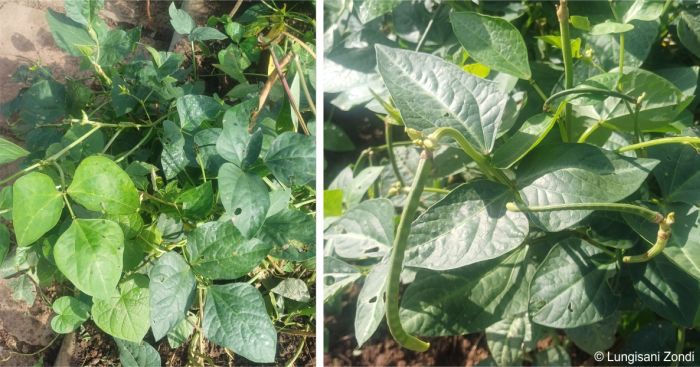
Description
Description
Vigna unguiculata is a versatile plant that can grow as an annual or perennial herb, depending on the environment. It can trail, climb, or grow in a semi-erect form, typically reaching heights of 150–900 mm, though climbing varieties can grow up to 2–3 m tall. The stems are hollow, smooth, and can range in colour from green to purple, with purple spots along the nodes. They can be 0.5–5 m long and 5–10 mm thick. Along the stems, the plant may form adventitious roots, which contain nitrogen-fixing nodules that help improve soil fertility.
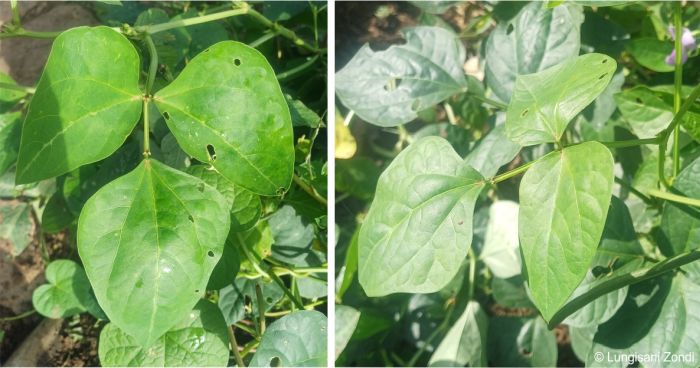
The leaves are trifoliate with petioles measuring 50–150 mm long and often showing a noticeable swelling at the base. The leaflets are variable in shape, ranging from lobed to triangular or elongated, with sizes ranging from 15–200 mm in length and 10–170 mm in width. The leaf texture can be soft or leathery, with some leaves covered in fine hairs. The plant also has stipules (small leaf-like structures), which can be large and green or small and brown, often with spurs. These stipules are lance-shaped, 6–20 mm long, with a narrower spur measuring 2–6 mm. Flowers grow in clusters of 2 to 7 blooms and come in shades of blue, mauve, or purple. The outer floral structure, or calyx, is bell-shaped, with lobes that may be hairy and become wrinkled with age. Flowering time is in spring and summer, from September-March, with flowers appearing in the leaf axils (angles between the stem and leaf) or at the tips of the branches. The fruit is a long, slender pod, about 200 mm in length. As it matures, the pod changes colour from green to light brown or dark brown and splits open to reveal 6–13 kidney-shaped seeds. The seeds vary in colour, including red, yellow-brown, or blackish-brown, and each has a dark ring at the point where it attaches to the pod.
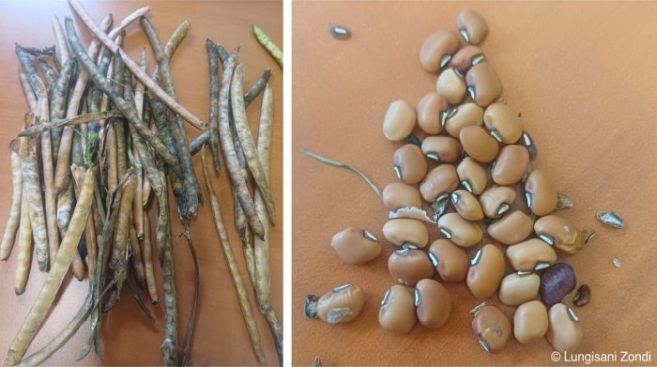
Conservation Status
Status
Vigna unguiculata is listed as Least Concern (LC) on the Red List of South African plants.
Distribution and habitat
Distribution description
Vigna unguiculata is indigenous to sub-Saharan Africa, with domestication believed to have occurred in West Africa around 6 000 years ago. It is thought to have been introduced to southern Africa during the Bantu migrations 1 500 to 2 000 years ago. Today, cowpea is widely cultivated in southern African countries such as South Africa, Zambia and Zimbabwe, valued for its resilience to drought and poor soils. The plant has spread globally, thriving in tropical and semi-arid climates, particularly in regions with annual rainfall between 400 and 700 mm.
Derivation of name and historical aspects
History
Vigna unguiculata belongs to the Fabaceae, a family known for its economic and cultural importance due to diverse edible vegetables, medicinal uses and nitrogen-fixing ability, reducing fertilizer costs. Fabaceae includes trees, shrubs and herbaceous plants, recognized by legumes and compound leaves. It is the third-largest plant family, with 765 genera and nearly 20 000 species worldwide.
The genus Vigna is named after Domenico Vigna, an Italian botanist who lived in the 1600s and worked as a professor and Director of the Botanical Garden in Pisa. The species name unguiculata is Latin for ‘with a small claw’, describing the tiny stalks found on the flower petals.
The genus Vigna includes about 150 species, mostly found in tropical regions worldwide, with the highest diversity in Sub-Saharan Africa. South Africa is home to about 16 species of Vigna. Among these, cowpea (Vigna unguiculata) stands out as a unique and complex crop, with many subspecies and wild relatives, all primarily originating from Africa. Over time, scientists have reclassified cowpea, grouping it under Vigna unguiculata subspecies unguiculata, which includes four main types (cultigroups). Modern tools like DNA markers have helped researchers better understand cowpea's origins, diversity, and relationships. Cowpea is believed to have originated in Sub-Saharan Africa, where wild varieties are still found today. Earlier theories suggested that cowpea had two separate origins, one in Africa and another in Asia. However, this idea has been dismissed because wild cowpeas do not exist in Asia. Cowpea's domestication began around 6 000 years ago when West African farmers cultivated it alongside pearl millet and sorghum.
The crop is thought to have been brought to South Africa around 1 600 years ago by Nguni-speaking communities. Along with cowpea, they introduced farming tools and skills like ironworking and pottery, which made it easier to store and manage harvested crops effectively. These communities also brought farming tools and knowledge of ironworking and pottery, helping them store and use harvested crops effectively. Today, cowpea is grown across Africa, Latin America, Southeast Asia, and parts of the southern United States. It is valued as a source of food, animal feed and vegetables. Despite its importance, wild cowpeas are sometimes confused with closely related plants like the wild sweetpea (Vigna vexillata). Adding to the challenge is the existence of over 700 cultivated varieties worldwide. In South Africa, cowpea is no longer widely grown because European bean varieties have largely replaced it in commercial farming. This shift has caused cowpea to become less common in rural areas, where it was once a staple crop.
Ecology
Ecology
Cowpea is a resilient crop, thriving under various climatic conditions, including hot and dry environments, without the need for irrigation or additional fertilizers. It grows well in poor soils due to its symbiotic relationship with Rhizobium bacteria, which form root nodules to fix atmospheric nitrogen. In return, the plant supplies the bacteria with carbon, creating a mutually beneficial partnership.
Cowpea is primarily self-pollinating, with pollination occurring before the flowers open. The pistil and stamen are enclosed within the keel, facilitating this process. However, cowpea flowers also produce nectar that attracts insects such as butterflies, houseflies and honeybees. Honeybees are the most active visitors, pressing the flower's wings to access nectar and inadvertently transferring pollen between flowers. Since cowpea pollen is heavy and sticky, insects, particularly honeybees, play a crucial role in cross-pollination, enhancing the plant's reproductive success.
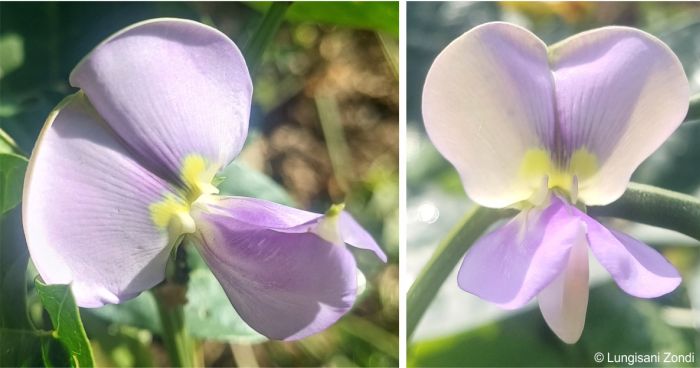
Uses
Use
Cowpea, Vigna unguiculata, is a versatile and culturally significant crop, particularly in Sub-Saharan Africa. Renowned for its high protein content (23–29%) and rich nutritional value, it provides essential amino acids, vitamins, minerals, and lipids, making it a vital food source for millions. All parts of the plant are utilized: the seeds are consumed in various forms, the tender leaves and pods are used as vegetables, and the tuberous roots are eaten in certain regions. Its slowly digestible starch adds to its health benefits.
Beyond human consumption, cowpea serves as livestock fodder and contributes to soil fertility through nitrogen fixation. Medicinally, it is used in traditional remedies for ailments such as fever, digestive issues and liver conditions. The seeds, roots and leaves are employed to treat burns, ulcers, smallpox and irregular menstruation. In Zulu medicine, cowpea-based emetics are used for fever and as love charms, while its roots are ground into snuff for headaches.
Culturally, cowpea holds sacred significance among the Hausa and Yoruba of Nigeria, used in rituals for protection and well-being. Its resilience, storage qualities and multifunctionality make it a cornerstone of traditional farming systems, particularly in West Africa, where it supports food security, traditional practices and livelihoods.
Growing Vigna unguiculata
Grow
Cowpea is easily propagated from seed, making it an accessible crop for growers of all experience levels. For optimal results, sow seeds in early spring (August in the southern Hemisphere). To enhance germination, scarify the hard-coated seeds by lightly sanding or soaking them in warm water overnight, allowing moisture to penetrate the seed coat. Prepare a well-draining potting mix using 2 parts compost, 1 part loam, and 1 part sand. Sow seeds 1–2 cm deep in seed trays or directly into prepared garden beds. In seed trays, plant one seed per compartment to avoid overcrowding. Transplant seedlings 2–3 weeks after germination, once they reach about 10 cm in height. For direct sowing, space seeds 5–6 cm apart with 60–80 cm between rows. Germination occurs within 15–20 days, with minimal need for specialized equipment like mist units or rooting hormones.
Cowpea thrives in warm climates with full sun exposure and an optimal growth temperature of 30°C. It tolerates various soil types, including sandy or slightly acidic soils, and demonstrates resilience in infertile or drought-prone conditions. While frost-sensitive, cowpea withstands high heat and grows best with moderate watering during its early stages. Prepare garden beds by loosening the soil and removing weeds. Incorporate compost or a balanced organic fertilizer. Mulch between rows to retain moisture and reduce weed growth. Once established, cowpea’s drought tolerance allows it to thrive with minimal additional watering.
Although not widely cultivated, cowpea’s hardiness, adaptability, and functionality make it a valuable addition to home gardens. Its trifoliate leaves and seasonal flowers enhance its aesthetic appeal, particularly as part of an indigenous vegetable garden. Cowpea pairs well with other indigenous crops such as sorghum, pearl millet, amaranth (Amaranthus spp.), African potato (Coleus esculentus), watermelon (Citrullus lanatus) and bottle gourd (Lagenaria siceraria), creating a diverse and visually appealing garden while promoting sustainable and nutritious food production.
Cowpea is susceptible to pests such as the brown garden grasshopper, legume pod borer and aphids, which can damage leaves, flowers and pods. Manage infestations using neem-based sprays or insecticidal soap, applying treatments early to limit damage. Fungal diseases like anthracnose and bacterial blight may occur in humid conditions or poorly drained soils. To prevent these, ensure good air circulation around plants and apply appropriate fungicides as needed. Postharvest pests can be mitigated using traditional methods like neem-treated storage bags or modern PICS bags, which are effective in preserving grain quality.
References
- Boukar, O., Belko, N., Chamarthi, S., Togola, A., Batieno, J., Owusu, E., Haruna, M., Diallo, S., Umar, M.L., Olufajo, O. & Fatokun, C. 2018. Cowpea (Vigna unguiculata): Genetics, genomics and breeding. Plant Breeding 138:415-424.
- Kirarei, E.K., Kipsumbai, P.K., Jeruto, P. & Kiprop, E.K. 2024. An overview on the taxonomy, distribution, production and economic importance of Cowpea (Vigna unguiculata L. Walp). Journal of Crops, Livestock and Pest Management 2(3):1-14.
- Lonardi, S., et al. 2019. The genome of cowpea (Vigna unguiculata [L.] Walp.). The Plant Journal 98(5):767-782.
- Panzeri, D., Guidi Nissim, W., Labra, M. & Grassi, F. 2022. Revisiting the domestication process of African Vigna species (Fabaceae): Background, perspectives and challenges. Plants 11(4):532.
- Pienaar, B.J. & Van Wyk, A.E. 1992. The Vigna unguiculata complex (Fabaceae) in southern Africa. South African Journal of Botany 58(6):414-429.
- Pooley, E. 1998. A field guide to wild flowers of Kwazulu-Natal and the eastern region. Natal Flora Publications Trust, Durban.
- Raimondo, D., Von Staden, L., Foden, W., Victor, J.E., Helme, N.A., Turner, R.C., Kamundi, D.A. & Manyama, P.A. (eds) 2009. Red list of South African plants. Strelitzia 25. South African National Biodiversity Institute, Pretoria.
- Van Wyk, B.-E. & Gericke, N. 2000. People's plants. Briza Publications, Pretoria.
- Vigna unguiculata (L.) Walp., 2022. English Wikipedia - Species Pages. Wikimedia Foundation. Checklist dataset. Available at: https://doi.org/10.15468/c3kkgh. Accessed on 2025/01/14.
- Xaba, P. & Croeser, P. Traditionally useful plants of Africa — their cultivation and use. Cambridge Universy Press, Cape Town.
Credits
Lungisani Zondi
Walter Sisulu National Botanical Garden
February 2025
Plant Attributes:
Plant Type: Bi/Annual, Climber, Perennial
SA Distribution: KwaZulu-Natal, Limpopo, Mpumalanga, North West, Northern Cape
Soil type: Loam
Flowering season: Spring, Early Summer
PH:
Flower colour: Purple, White, Pink
Aspect: Full Sun
Gardening skill: Easy
Special Features:
Horticultural zones
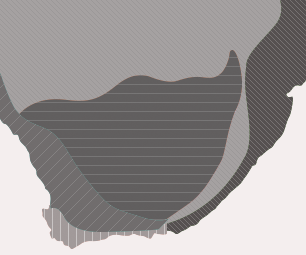










Rate this article
Article well written and informative
Rate this plant
Is this an interesting plant?
Login to add your Comment
Back to topNot registered yet? Click here to register.